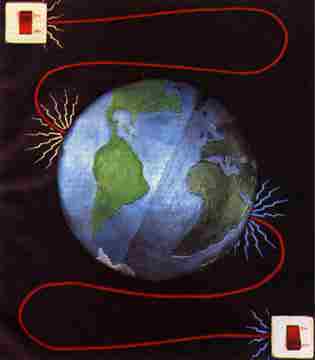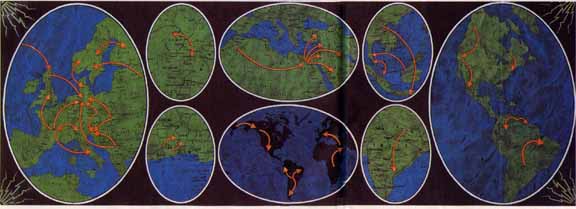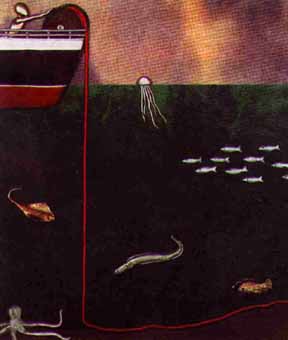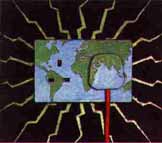
8 July 1995 No 1985
Weekly £1.70
New Scientist:
GLOBAL POWER — The electric hypergrid
THE INTERNATIONAL GRID
WHEN
Arab energy ministers met in Cairo in April, there
was one thing at the top of their agenda-plans
for a regional electricity grid that would stretch
more than 5000 kilometres from Morocco in the
west to the Gulf states in the east. And for Maher
Abaza, Egypt's energy minister and the meeting's
host, that would only be the start. Abaza foresees
a network, with Egypt at its heart, that would
give the energy-hungry countries of Europe access
to the hydropower of Africa's mightiest rivers.
Ultimately, he envisages a worldwide power system
that would cut the cost of electricity everywhere.
This, says Abaza, represents "the hope for the
peoples of the developing world".
Abaza is following in the footsteps
of Richard Buckminster Fuller, the maverick
American architect and futurologist who was
born 100 years ago next week. Buckminster Fuller
is remembered chiefly for his geodesic domes,
but he also dreamt of continents linked by high-voltage
pylons and undersea cables. In the mid-1970s
he predicted that the world would one day have
a global electricity grid. Now engineers are
planning the links that could eventually grow
into an international network, distributing
power from the rainforests of Borneo and the
geothermal rocks of Iceland, the Zaire river
and France's nuclear power plants.
|

Dreams of a global electricity grid are
close to reality. Fred Pearce looks ahead
to a world in which electrical power is traded
worldwide
|
In Anchorage, Alaska, the talk is of a project
to bring hydroelectricity from Siberia to North
America through a submarine power line. The
Bering Strait, which separates Russia and Alaska
is only 85 kilometres wide and 50 metres deep,
but the cable could cost some $2 billion to
lay. "We've put eight years' work into engineering,
geological and environmental studies," says
George Koumal, chairman of the Interhemispheric
Bering Strait Tunnel Group, which wants to combine
the power link with a railway tunnel. Now he
is looking for finance and, in September, comes
to London for a fund-raising conference.
Last November, plans were revived to harness
up to 37 000 megawatts of generating capacity
on the Mekong river, which runs for more than
4000 kilometres from China, through Burma, Laos,
Thailand, Cambodia and Vietnam. Power lines
already straddle the river, linking the site
of the Nam Ngum dam, near Vientiane, to the
Thai border, and construction began this year
on another, much larger "export dam" in Laos
on the Nam Theun river, a tributary of the Mekong.
"It is our hope to build a power grid in the
region that will allow the six countries to
utilise power most efficiently," says Noritada
Morita, director of the Asian Development Bank,
which is contributing funds.
The Mekong links may lead to a larger southeast
Asian grid. Malaysia and Thailand, two of the
world's fastest-growing economies, are planning
cross-border power connections. And, next year,
Malaysia is due to begin building a giant hydroelectric
plant at Bakun on the Balui river in the rainforest
of Sarawak on the island of Borneo. The power
station, capable of generating 2400 megawatts,
will supply electricity to the mainland through
a 650-kilometre cable on the bottom of the South
China Sea. Any power that Malaysia does not
need will go to Brunei or the Indonesian state
of Kalimantan, which between them occupy the
rest of Borneo, or to Singapore, says the Malaysian
government.
|
The Himalayan kingdom of Nepal is another remote
region with a large hydroelectric potential. It currently
has the lowest per-capita energy consumption of any
nation on Earth the capacity of the national system
is just 278 megawatts but, according to its Water
and Energy Commission, could generate more than 40
000 megawatts of hydroelectricity in its steep valleys.
The Arun III hydroelectric project, the first of three
dams on the Arun river, which will generate 1500 megawatts,
is about to receive funding from the World Bank. This
is likely to be followed by another, generating 11
000 megawatts and costing $6 billion, in the Chisapani
Gorge just 45 kilometres from the Indian border. And
Nepal has plans for more than ten other schemes.
Himalayan potential
Nepal is about to build the long distance
power lines to transport the electricity these schemes
will generate. Its first customers will be the great
industrial cities of northern India, a region of 300
million people where rapid industrial development
has led to frequent power cuts. Indian planners are
also eyeing Nepal s Himalayan neighbour, Bhutan, which
has an estimated potential for generating 20000 megawatts
of hydroelectric power.
But at present, the world's largest
exporter of electricity is Paraguay. The Itaipu dam
on the River Parana is the world's biggest power complex
with a capacity of 12 600 megawatts from where power
is fed to Rio de Janeiro and Sao Paulo in Brazil.
Such vast projects appall many environmentalists,
who point to the ecological damage they can cause.
But not all US Vice-President Al Gore, who is noted
for his environmental concerns, says: "A global energy
network makes enormous sense it we are to meet global
energy needs with a minimal impact on the world's
environment."

Intercontinental electricity grids are the only way
to harness the planets great sources of renewable energy
and link them to centres of population according to
Peter Meisen of Global Energy Network Institute in San
Diego this nonprofit-making organisation is dedicated
to promoting Buckminster Fuller's vision of a global
grid. "Modern transmission lines can efficiently span
up to 6000 kilometres, says Meisen. This is enough to
bring power to large industrial centres from hydroelectric
sites on the great Arctic rivers, such as the Ob and
Yukon, Mackenzie and Lena and tidal power sites in Argentina,
China, Australia and India. A global grid could also
tap solar power right round the tropics and the geothermal
potential of the "ring of fire" round the Pacific Ocean,
in Iceland and in the Rift Valley of Africa.

Modern society is founded on electricity,
in 1990, the world's power stations pumped out enough
power for every person on the planet to run four 60-watt
bulbs permanently. And production is growing fast.
Output was up 134 per cent from 1970 to 1990, while
the global population rose by just 40 per cent. That
puts electricity well ahead of cars (up 124 per cent
in the same time), cigarettes (75 per cent) or oil
(41 per cent).
'Modern
society is founded on electricity. More investment
now goes into distributing than generating it,
and lines of pylons are extending round the globe
faster than roads, connecting two-thirds of the
population' |
More investment now goes into distributing
electricity than generating it, and lines of pylons
are extending round the world faster than roads. Four
billion people, or around two-thirds of the world's
population, are connected to distribution networks,
Many began as local enterprises, but more and more
have become international, so that today more than
50 nations have electrical interconnections with their
neighbours.
Such links can be complex. All grids
run on alternating current, but the frequencies and
other specifications often differ from country to
country, so giant transformers have to be installed
at borders, These usually convert AC power from one
country into direct current and then back into AC
to meet its neighbour's specification. This is expensive.
A link from Germany to the Czech Republic, completed
in 1993, cost $180 million.
International links allow countries
to share their generating capacity, and smooth out
surges in demand. These can occur at various times
of day: during the morning switch-on of factories,
or the evening rush for the kettle at the end of a
popular TV programme, for example. A link can reduce
the number of power stations both partners need to
build to cope with these peaks. Take the submarine
cable linking Britain and France, which came into
service in 1986. In England and Wales, average winter
demand is 38 000 megawatts, but at peak times the
load rises to 47 500 megawatts. France can help out
because it has spare generating capacity and its peak
load comes at different times from Britain's.
Mix and match
Different types of power station have different capabilities,
and international links can help here too. Nuclear power
stations can take several days to switch on or off,
so they are best at providing continuous, "base-load"
electricity, A hydropower generator can be started in
seconds, making it ideal for meeting surges. Switzerland
imports base-load electricity from French nuclear power
plants, but exports power from its Alpine dams in short
bursts to meet France's peak-load needs.
Long-distance power lines may also
allow several countries to benefit from a remote source
of cheap power. The world's ten largest power stations
are all hydroelectric plants, and most of them are
far from their markets. Four are in Siberia three
in remote regions of South America and two in northern
Canada.

The Achilles heel of pylon links is
their vulnerability in wartime. The classic example
is Mozambique's hydroelectric dam on the River Zambezi
at Cabora Bassa, which was completed in 1976. Built
to fuel the gold mines of South Africa 1300 kilometres
away, it is capable of delivering 4000 megawatts of
electricity more than ten times Mozambique's domestic
demand. During two decades of civil war in Mozambique,
the pylon link was regularly cut by antigovernment
guerrillas. Only now, two decades on, can the dam
do the job it was designed for.
But power links can be a force for
Peace. Following the Israel-Jordan peace pact last
October, the two states plan to join their grids.
A World Bank study last year spelt out the advantages.
"As Israel and Jordan have sharply different daily
and weekly load peaking patterns, interconnection
of their national grids would permit mutually profitable
trading between power utilities, and reduce the need
for costly back-up capacity for each country, the
report concluded.
The Bank also proposed connecting
Israel to the Jordan-Egypt link now being built under
the Red Sea, and a large hydroelectric project for
the rift valley between the Red Sea and Dead Sea,
the lowest-lying lake in the world. The scheme would
exploit the 400-metre level difference between the
two seas by building a canal between them and a hydroelectric
power plant on the shores of the Dead Sea. The power
station would spur industrial development in the region,
and power a desalination works that would supply water
to farms and resorts.
During the l950s, the colonial powers
in Africa created several international dams. Besides
Mozambique's Cabora Bassa dam, built by the Portuguese,
the Kariba dam on the Zambezi has, since its construction
in the 1950s, been the mainstay of the interconnected
Zambian and Zimbabwean electricity grids. And Ghana's
Akosombo dam, conceived by the British and executed
shortly after independence, exports power to neighbouring
Togo and Benin.

But some more recent schemes have
collapsed because of lack of funds. The Manantali
dam on the upper reaches of the Senegal river in the
West African state of Mali was completed in 1987.
It was intended partly to generate power for Dakar,
the capital of Senegal more than 1000 kilometres away
on the Atlantic coast. Rut the money ran out and,
almost a decade on, the gaps left in the dam for the
turbines remain empty and the pylon route to Dakar
is no more than a line on the map.
The densest network of links is in
Europe. The countries of mainland Western Europe own
14 per cent of the world's electricity generating
capacity and, for around 50 years, they have been
joined by a system of AC links known as the Union
for the Cooperation of Production and Transmission
of Electricity. The system is connected by DC links
to a Scandinavian grid via Denmark, and to Britain
by the Channel link.
Czech mate
There is a similar network in Eastern Europe, and a
growing number of links between the two. They were being
built even before the Berlin Wall fell In thc 1980s,
Czechoslovak dams began supplying power to Germany and
Austria which also established pylon links with Hungary
and the former Yugoslavia. In mid-1993, the capacity
of the direct connections between West and East Europe
was doubled with the completion by the German and Czech
governments of a DC link near Weiden in Bavaria.
The East European and Scandinavian
grids are both connected to the United Power System,
which cove s the former Soviet Union and taps Siberia
S giant hydroelectric plants. Until 1989 the UPS was
a major exporter of power to Eastern Europe. Since
then industrial decline has reduced the trade.
But within Europe, international trade
in electrical power is rising fast. During the 198Os,
when the amount of power generated increased by half,
the trade in electricity doubled, Austria, France
and Switzerland export more than 10 per cent of their
production, while Finland, Italy and Portugal import
more than 10 per cent of their requirements. Germany
exports power during off-peak hours, but is 1an importer
during peak periods, especially in summer.
Sea links
The sea is only a minor obstacle to European grid-builders.
The cross-Channel link is 50-kilometres long, and Norway
and Denmark are joined by a 125-kilometre submarine
cable across the Skagerrak. The world's longest submarine
link stretches for 200 kilometres along the bottom of
the Gulf of Bothnia, linking Finland and Sweden. Two
years ago, Icelandic engineers proposed laying a 1000-kilometre
cable beneath the North Atlantic to Scotland, to allow
the island to exploit its hydroelectric and geothermal
potential by selling electricity to Britain and continental
Europe.

In North America, there are two prime grids, both cross-border,
covering the east and west of the US and Canada. Power
from Quebec's hydroelectric plants around James Bay,
with a combined capacity of 15 000 megawatts, is brought
south on five high energy power lines into the northeastern
US. The link provides a tenth of New York City's power.
Opposition from Cree Indians, whose land was to be flooded,
recently halted Hydro-Quebec's plans to double the capacity
of the James Bay complex. "We regard this as a temporary
setback," the giant state enterprise says.
Such regional networks could be the
potential building blocks of a global grid. Besides
the Alaska link, Russian engineers want to export
power from their Siberian dams to the industrial centres
of China, Japan and Korea, the top priority being
a Russia-China link. The two countries plan a cascade
of clams on the Amur river in Manchuria, where it
forms the border between them, before cutting across
Russian territory and into the Pacific Ocean.

While the superpowers shape up for
electrical union, the developing world is looking
to transnational electricity grids to promote economic
development. In 1993, the African Development Bank
agreed to pay for a feasibility study into erecting
a 4000-kilometre power line from Zaire to Egypt, passing
through the Central African Republic, Chad and Sudan.
The idea is to turn the Zaire, the second largest
river in the world, into a power source for much of
northern Africa.
Black power
The river could provide up to 20 000 megawatts of electricity
from one site, the Inga Falls, between Kinshasa and
the Atlantic Ocean. There is already a hydro power station
at the falls which sends electricity south to copper
mines in southern Zaire and Zambia. Twenty years ago,
South Africa proposed expanding its capacity to create
more power for southern Africa, where power lines already
link South Africa, Zimbabwe, Botswana, Namibia, Lesotho,
Swaziland and Mozambique. Northern Africa need not worry,
though. The Inga Falls could, in theory, supply more
than twice the current electricity demand of the whole
continent.
The idea of a single site powering
the whole of Africa may be absurd, But as electricity
demand across the planet grows, the case for ever
larger regional electricity grids becomes stronger.
"In future," says Meisen, "it will be possible to
meet Buckminster Fuller's vision of interconnecting
continents A global electricity grid is too large
a project to be built as a single endeavour. But,
like the emerging worldwide grid of transcontinental
highways it could happen nonetheless.

|









